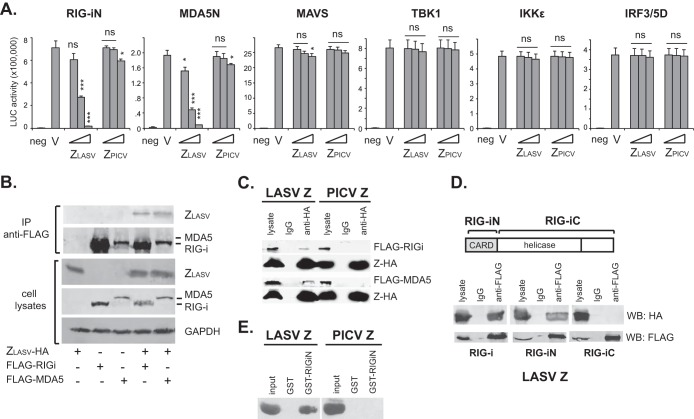FIG 2.
LASV Z inhibits RLR signaling by interacting with RLRs at the N-terminal CARD domains. (A) LASV Z inhibits type I IFN activation induced by RIG-iN and MDA5N but not by MAVS, TBK1, IKKε, or IRF3/5D. 293T cells were transfected with empty vector (V) or increasing amounts of PICV or LASV Z plasmids (10, 100, and 1,000 ng), IFN-β–LUC, and plasmids expressing the respective IFN activators. neg, negative control (no RIG-iN or MDA5N transfection). Each sample was compared to the vector control by statistical analysis using the Student t test. *, P < 0.05; ***, P < 0.001; ns, no statistical significance. (B) LASV Z can interact with RIG-i and MDA5. HA-tagged ZLASV and FLAG-tagged full-length RIG-i or MDA5 were cotransfected into 293T cells. Cell lysates were immunoprecipitated with anti-FLAG antibody and detected by anti-HA or anti-FLAG. (C) LASV Z, but not PICV Z, can interact with RIG-i and MDA5 by inverse coimmunoprecipitation. 293T cells were cotransfected with HA-tagged LASV or PICV Z plasmid and FLAG-tagged full-length RIG-i or MDA5. The cell lysates, IgG, and anti-HA immunoprecipitates were detected by Western blotting with anti-FLAG and anti-HA antibodies. (D) LASV Z interacts with the N-terminal CARD domain, but not the C-terminal domain, of RIG-i. HA-tagged ZLASV was cotransfected with FLAG-tagged full-length RIG-i, RIG-iN, and RIG-iC, respectively. The Z proteins in the cell lysates, IgG, and anti-FLAG immunoprecipitates were detected by Western blotting with anti-HA and anti-FLAG antibodies. (E) LASV but not PICV Z directly binds to the N-terminal region of RIG-i. In vitro-translated and biotin-labeled LASV Z and PICV Z proteins were incubated with purified GST or GST-tagged RIG-iN domain (GST-RIG-iN) in vitro. After GST pulldown, the associated Z proteins were detected by Western blotting with streptavidin-HRP followed by chemiluminescent detection.

